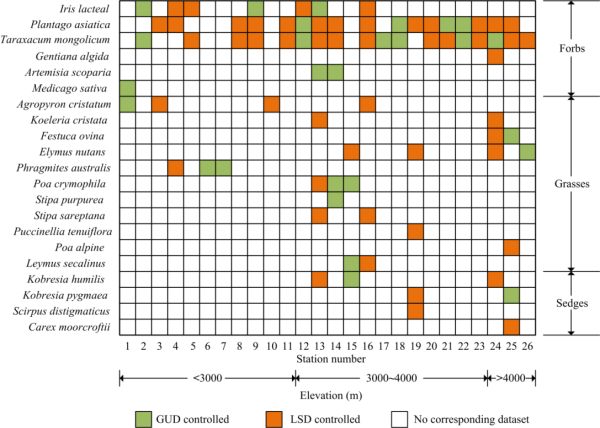

Plant phenology is a sensitive bio-indicator of climate and natural environment change. Shift in plant phenology and its response to climate change on the Qinghai–Tibetan Plateau (QTP) have been a hot research topic during the recent decade. On the QTP, previous phenological studies have shown an overall lengthening trend of the growing season length (GSL) and most of them suggest that earlier spring green-up date (GUD) is the main contributor to the prolonged GSL. These studies, however, are mainly based on remote sensing data to derive phenological metrics, which have large uncertainties and are difficult to validate the accuracy and precision. Researches based on ground-observed phenological data can provide more reliable and accurate information on the growing season variations, but they are very few on the QTP by far.
The postdoctoral fellow SUN Qingling, under the guidance of Prof. ZHOU Guoyi, collected a large number (1455+ records) of long-term and continuous phenological observation data during 1981–2017 at all the ground phenological stations across the QTP. Based on those data, they conducted comprehensive analyses of temporal changes in spring GUD, autumn leaf senescence date (LSD), and GSL from 1981 to 2017, and evaluated the relative contribution of shifts in GUD and LSD to change in GSL using the C-index.
Results showed that the overall trends of GUD, LSD, and GSL insignificantly advanced, significantly delayed, and significantly lengthened, respectively. On average, the relative contribution of LSD shift to GSL change was 69.3% which was more than twice that of GUD shift (30.7%). Therefore, it was mainly the delayed LSD, rather than an advanced GUD, that prolonged the GSL of QTP herbaceous plants, which was contrary to the prevailing conclusion reported by previous studies.
This study suggests that the importance of autumn phenology has been underestimated on the QTP, and more attention should be paid to the shift in autumn phenology and its influences on ecosystem structure and function in the future.
This research entitled “Delayed autumn leaf senescence date prolongs the growing season length of herbaceous plants on the Qinghai–Tibetan Plateau” has been published recently in Agricultural and Forest Meteorology. For further reading, please refer to: https://doi.org/10.1016/j.agrformet.2019.107896.

Figure. The primary controller (spring GUD or autumn LSD) of the temporal change in GSL for main herbaceous plant species on the Qinghai–Tibetan Plateau

